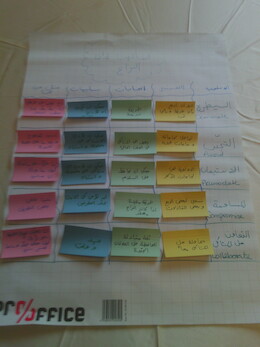Toolbox — For Training and Youth Work
All new tools in your inbox: Be the first to know about new tools for learning with our e-mail notifications.
Exercise
Conflict Styles
Every person has a preferred style to handle conflicts.This tool will help participants understand the 5 conflict management styles through their meanings, pros, cons and examples using a Market where meanings, pros, cons and examples are sold.
Aims of the tool
1. Identify the 5 Personal Conflict Management Styles
2. Understand the meaning, pro, con of each style in addition to examples
3. Discuss each style using the Goals/Personal Relationships scale
4. Undergo a self evaluation to understand the personal conflcit management style
Description of the tool
PREPARATIONS
Step 1:
Trainer to read "Conflict Management Styles" document as Background Information.
Step 2:
"Conflict Styles Market" to be printed in colors. and Each paper to be cut into 6 pieces as per table inside the document. Result: 4 sets (Blue set, Pink set, Green Set, Purple Set) Each set has 6 cards
Step 3:
Trainer prepares a flip chart as per attached document entitled "Flip Chart" and prints the CONFLICT MANAGEMENT STYLE QUIZ for each participant
WORKSHOP DELIVERY
Trainers starts with a brief introduction explaining that people handle conflicts differently and that there are 5 different conflict management styles. In addition, each situation might require a different style. Then he explains that this workshop will explain the different styles, and will allow participants to do a self evaluation which will reveal the style mostly used by each one to handle conflicts, and this is the first step which will help us to handle conflicts differently in the future.
Trainer after that names the 5 styles by showing the pre-prepared FLIP CHART and explains that each style has a MEANING, a PRO, a CON and an EXAMPLE and these will be sold to the trainer by the participants themselves.
After that participants will be divided into 4 groups, each representing a market as per the "CONFLICT STYLES MARKETS".
So group 1 will be the MEANINGS MARKET and will be given the BLUE SET OF CARDS.
Group 2 will be the PROS MARKET and will be given the PINK SET OF CARDS
Group 3 will be the CONS MARKET and will be given the GREEN SET OF CARDS
Group 4 will be the EXAMPLES MARKET and will be given the PURPLE SET OF CARDS
Trainer will then name a conflict style and will ask each market to sell him the corresponding meaning, pro, con and example and before sticking it on the FLIP CHART, other participants can agree or disagree if this is the true meaning, pro, con or example. Trainer will correct at the end before sticking the right info on flip chart.
After this exercise, Trainer will explain in detail each style using the CONFLICT STYLES CHART document and the background info from the CONFLICT MANAGEMENT STYLES document.
Later on, participants are given the CONFLICT MANAGEMENT STYLES QUIZ to reflect on their personal conflict management style with support from trainer
Disclaimer
SALTO cannot be held responsible for the inappropriate use of these training tools. Always adapt training tools to your aims, context, target group and to your own skills! These tools have been used in a variety of formats and situations. Please notify SALTO should you know about the origin of or copyright on this tool.
Tool overview

http://toolbox.salto-youth.net/1590
This tool addresses
Conflict Management
It is recommended for use in:
Training and Networking
Capacity Building
Materials needed:
Flip Charts
Printed Documents attached to this tool
Duration:
60 minutes
Behind the tool
The tool was created by
Lama Zeinoun Tabet
in the context of
Training on Conflict Mitigation
The tool has been experimented in
Training on Conflict Mitigation
The tool was published to the Toolbox by
Lama Zeinoun Tabet (on 18 March 2015)
and last modified
22 December 2014
Comments
No comments have been posted yet.
If you want to comment on this tool, you need to be signed in with your MySALTO account. Sign in now